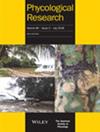干燥和盐度梯度对日本鹿儿岛潮间带褐藻纺锤形马尾藻PSII光化学效率的影响
IF 1
4区 生物学
Q2 MARINE & FRESHWATER BIOLOGY
引用次数: 4
摘要
采用脉冲幅度调制(PAM)‐叶绿素荧光仪测定了潮间带可食用褐藻马尾藻(Sargassum fususiforme (Harvey) Setchell,马尾藻科,Fucales)的光化学效率对干燥和盐度梯度的响应。有效量子产率(ΔF/Fm’;= ΦPSII)的光系统II (PSII)在低光照(20 μmol光子m−2 s−1)和高光照(700 μmol光子m−2 s−1)下在20°C和50%相对湿度下暴露360 min后降为零。在这些条件下,即使在海水中补液1天后,ΔF/Fm'也未能恢复到初始水平。一般情况下,ΔF/Fm'随着干燥降低绝对含水量(AWC, %)而降低。然而,当AWC高于约20%时,ΔF/Fm'在海水中复水1天后大部分恢复到初始水平,表明对脱水有较强的耐受性。此外,梭状镰刀菌在6天的培养过程中似乎能够耐受广泛的盐度范围(即15-50 psu);当盐度<10和60 psu时,ΔF/Fm′下降。对脱水和盐度胁迫的强耐受性可能为梭状梭菌提供了一个优势,使其能够在潮间带栖息地繁衍生息。本文章由计算机程序翻译,如有差异,请以英文原文为准。
The effects of desiccation and salinity gradients on the PSII photochemical efficiency of an intertidal brown alga, Sargassum fusiforme from Kagoshima, Japan
The responses of photochemical efficiency to desiccation and salinity gradients in an intertidal edible brown macroalga, Sargassum fusiforme (Harvey) Setchell (Sargassaceae, Fucales), were determined using a pulse amplitude modulation (PAM)‐chlorophyll fluorometer. The effective quantum yields (ΔF/Fm'; = ΦPSII) of photosystem II (PSII) dropped to zero after 360‐min aerial exposure under low irradiance (20 μmol photons m−2 s−1) and 120‐min exposure under high irradiance (700 μmol photons m−2 s−1) for this species at 20°C and 50% relative humidity. Under these conditions, ΔF/Fm' failed to recover to initial levels even after 1‐day rehydration in seawater. In general, ΔF/Fm' decreased as desiccation reduced the absolute water content (AWC, %). Nevertheless, when AWC was above ca. 20%, ΔF/Fm' was mostly restored to initial levels after 1‐day rehydration in seawater, suggesting strong tolerance to dehydration. Furthermore, S. fusiforme appeared to tolerate a broad range of salinity (i.e. 15–50 psu) during six days of culture; however, ΔF/Fm' declined when salinity was <10 and 60 psu. Strong tolerance to dehydration and salinity stress likely provides S. fusiforme an advantage that allows it to flourish in the intertidal habitat.
求助全文
通过发布文献求助,成功后即可免费获取论文全文。
去求助
来源期刊

Phycological Research
生物-海洋与淡水生物学
CiteScore
3.60
自引率
13.30%
发文量
33
审稿时长
>12 weeks
期刊介绍:
Phycological Research is published by the Japanese Society of Phycology and complements the Japanese Journal of Phycology. The Journal publishes international, basic or applied, peer-reviewed research dealing with all aspects of phycology including ecology, taxonomy and phylogeny, evolution, genetics, molecular biology, biochemistry, cell biology, morphology, physiology, new techniques to facilitate the international exchange of results. All articles are peer-reviewed by at least two researchers expert in the filed of the submitted paper. Phycological Research has been credited by the International Association for Plant Taxonomy for the purpose of registration of new non-vascular plant names (including fossils).
 求助内容:
求助内容: 应助结果提醒方式:
应助结果提醒方式:


